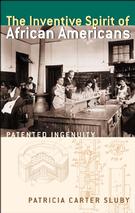 |
The Inventive Spirit of African AmericansTable of Contents: Several inventors named in the book:Robert G. Bayless (click here for picture), a native of Ohio, is a chemist who has excelled in the field of microencapsulation. He is the recipient of over a dozen patents. John Pelham Beckley, a Howard University trained pharmacist, turned to metal sculpture in 1974, and has been practicing the bronze casting ever since. Born in Washington, D.C. in 1930, Beckley was smitten with creative thinking early in life, nurtured and encouraged by his elders. His maternal grandfather Robert Pelham and his brother, Charles Randolph Beckley, both are patent-awarded inventors. Homo sapiens have been casting metal for eons, and Beckley, knowing that early metal casters did not go to foundries, believed that he, too, could use earth, wind and fire to do what they did. Beckley’s work with casting led him to invent an apparatus that he calls “The Melting Pot,” trademarked equipment that melts bronze without the artist ever leaving home (click here to view a picture of the Melting Pot. It was Beckley’s coffee pot that inspired him to design and construct the device, patented as a vertical lifted portable electric furnace. The furnace or “pot” is plugged into a household electrical outlet and heats about ten pounds of bronze at 2000 degrees Fahrenheit. The liquid metal is then poured into a mold. With this equipment Beckley casts his sculptured art pieces. An example of diverse female ingenuity is the story of Henrietta Mahim Bradberry of Chicago, Illinois. Bradberry, born in Franklin, Kentucky, finished a secondary-school education and is credited with two patent documents. On May 25, 1943, she patented a bed rack that was an attachment that permitted air to pass through and refresh worn clothes. Two years later, during World War II, apparently motivated by patriotic feelings, her interest centered on, amazingly, a torpedo discharge means. Patented in 1945, the complex device operated pneumatically and could discharge torpedoes below the water surface while located in submarines or in subterranean forts. (click here to view the patent drawing) It had three gears giving the capability of firing multiple torpedoes rather than the standard single charge. The discharge device prevented the water from penetrating into the effective mechanism. Before Bradberry’s death in 1979, she told this author that “ideas just came” to her. As a homemaker, she had time to “work out the concepts to perfection” and, of course, to the satisfaction of the Patent Office. Dr. Percy Lavon Julian (read about this grandson of slaves). |